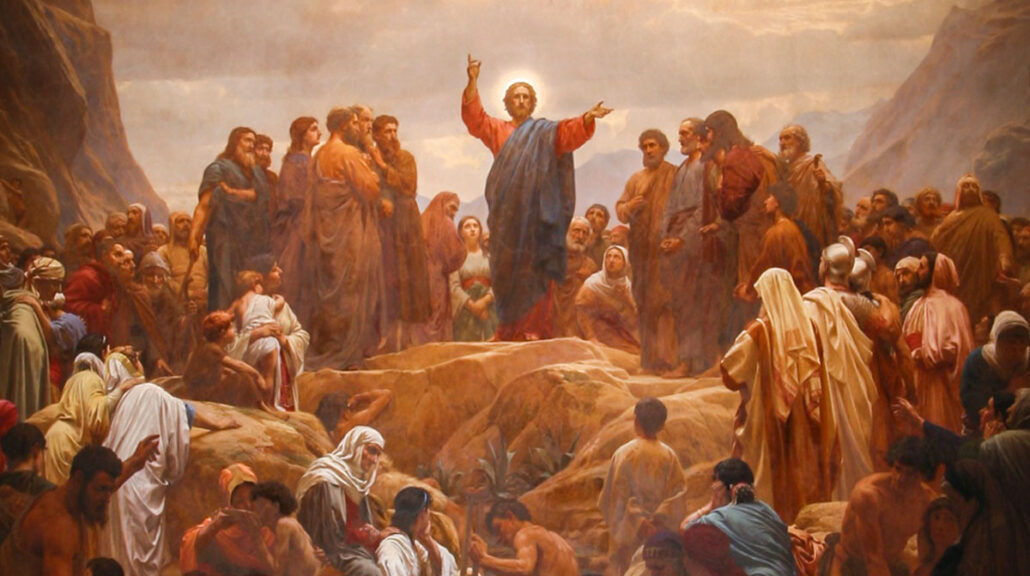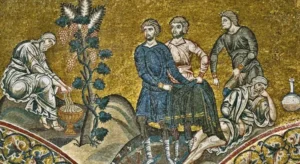Question:
Does Jesus Christ teach that divorce is lawful at least in certain exceptional cases? How are Christ’s words in Matthew to be interpreted: ‘except in case of adultery’?
Response:
Matrimony is indissoluble by nature and by positive institution of God: by nature because without indissolubility the ends of marriage are not attainable [1]; and it is also a positive institution of God that goes back to the very moment of creation, as can be seen in the words of Genesis (2:24): “For this reason, a man leaves his father and mother and cleaves to his wife, and they become one flesh.” In this sense, Christ interprets them: “In the beginning it was not so… what God has joined together, let no man put asunder.” (Mt 19:6)
Consequently, divorce (understood in the case of valid marriages) contradicts the positive precepts of God and natural law. Theologians are explicit in saying that it contradicts the secondary natural law, that is, the set of precepts whose observance facilitates the attainment of the primary end; this can be achieved, but with difficulty and not always. The secondary precepts follow, as conclusions, from the primary ones.[2]
However, historically speaking we know that the Mosaic Law permitted the practice of divorce i.e., it allowed a man to separate from his wife and remarry, at least in some cases.[3] When was it permitted? The Mosaic Law simply says, “If a man marries a woman who becomes displeasing to him because he finds something indecent about her” (Dt. 24:1).The school of Rabbi Hillel was lax and held that the husband could divorce his wife for any clumsiness (even if she let the food burn). That of Shammai was more rigoristic and said that Moses’ statement refers to serious moral wrongdoing, i.e., only in the case of the wife committing adultery.
Jesus Christ, in arguing with the Pharisees who put the case to him, makes it clear that the reason for this divine permission was hardness of heart. He takes it for granted that God could dispense from his positive law and natural law in this case. He does so only as a dispensation, to avoid greater evils: the fact that God does not approve of the custom but limits himself to regulating the practice of divorce as a lesser evil is expressed in what he says in Malachi 2:14-16, “For I hate[c] divorce, says the Lord the God of Israel, and covering one’s garment with violence, says the Lord of hosts. So take heed to yourselves and do not be faithless.” Now, why can God dispense from the natural law in this case? The explanation that St. Thomas gives is that indissolubility pertains to the secondary natural law, as we have said, whereby God – and only God- could dispense from it for serious reasons.[4] The serious motive here was to avoid the crime of congicide or uxorcide, which the hard hearts of the Jews would not hesitate to commit. Some of the Church Fathers (St. John Chrysostom, St. Jerome, St. Augustine) and St. Thomas himself deduce that this is the “hardness of heart” that Christ is referring to, based on the words in Deuteronomy 22:13, “”If any man takes a wife and goes in to her and then turns against her.”[5}
Now, what attitude does Christ have towards this? Jesus Christ legislated on divorce by explicitly repealing the dispensation that governed the Old Testament.[6] This appears in four places in the Gospel: Mt 5:31, Mt 19:3-9, Mc 10:20-21 and Lk 16:18. However, at the very moment that Our Lord restores the original indissolubility, an expression appears on His lips (although only in the two texts of Matthew) that would seem to grant certain exceptions (i.e. some possibility for divorce): except in the case of adultery, except in the case of fornication. Thus, is it a question of absolute indissolubility or in the majority of cases? To answer this question we must analyze the texts.
The problem presented by the two texts from St. Matthew
The text of chapter 19 of St. Matthew must be interpreted, taking into account the historical context in which the discussion takes place. Christ is discussing with the Pharisees and they are the ones who bring up the question of divorce. The question aims to see which of the most important opinions of the time (Hillel’s or Shammai’s) Jesus is enrolled in.
Jesus Christ responds, appealing the original intention of God in Genesis: 4 “Haven’t you read,” he replied, “that at the beginning the Creator ‘made them male and female,’ (Mt 19:4-5) and said, ‘For this reason a man will leave his father and mother and be united to his wife, and the two will become one flesh?; and He finished his reasoning saying: Therefore what God has joined together, let no one separate.” (v. 6).
The Pharisees clearly understand that Jesus Christ does not consider any possibility (not even the restrictive case of Shammai), which is why he objects to the permissive attitude of Moses. Jesus Christ, therefore, must explain how Moses’ attitude should be interpreted and defend his uncompromising position, which he will do by appealing again to the original intention of the Creator (In the beginning it was not so: Mt 19:8) and explaining the reason for the Mosaic attitude (it was due to the hardness of the Jews’ hearts; which we already indicated in what sense this is understood).
Now, Jesus Christ, after recalling the Mosaic permission, is going to legislate by reinstating marriage in its original force. He is aware that he is repealing a transitory law of the Old Testament; that is why he introduces the new legislation (at least in the text of Mt 5)[7] with the words: But I say to you, a locution with which in the Sermon on the Mount he opposes precisely to the teachings of the ancients his own superiority [8]. In addition, what is the teaching that he opposes to what he said to the ancients? Whoever divorces his wife (unless it is adultery) and marries another woman commits adultery (Mt 19:9; cf. Mt 5:32).
Here is the problem. Mathew 19:9 – except in the case of adultery (mé epì porneía); Mt 5:32 – except in the case of fornication (parectós logou porneías)[9]. The nucleus of the problem consists, in reality, in the correct interpretation of the two Greek expressions.
Before presenting different opinions on the matter, there is one thing that is clear and cannot be discussed and that is the logic that Christ must follow; it cannot give itself an interpretation, which psychologically “fractures” Jesus’ reasoning.
However, Christ, at the height of discussion, has already indicated: first, that “in the beginning” (that is to say in creation) the marriage situation was not the same as it was in the time of Moses. Secondly, that Moses granted repudiation not as a spiritual progress but as a setback due to the hardness of heart of his people. Thirdly, Jesus intends to return to the situation in Genesis (all of this is in Mt 19). Fourthly, that their legislation is contrary to what was taught to the ancients (this in Mt 5). Nevertheless, if the controversial expression could be understood literally ‘except in case of adultery’, Christ would not have left the Mosaic framework; he would still be in it, framed in the position of Shammai. Therefore, after announcing an abrogation of the dispensation, we won’t have any more than the consecration of one interpretation of the dispensation. In the rationalization of Christ, we find a fractured logic or a backing down in the face of the objection of his adversaries. This difficulty was noted from a long time ago, and the reasons for which many neo-protestants and modernist wanted to explain the exceptions of Christ like a interpolation of wording: someone added this expression to the original text (like when it says, for example, Loisy). This explanation does nothing but avoid the problem.
Tradition has sought, instead, to explain Christ’s thoughts in two ways: either by interpreting the particles mé, and parectós in another way, or by studying the concept of porneía in greater depth. The main ones are the following:
- For some the expression should be understood like it’s been translated generally (‘like in the case of adultery or fornication’) but what Christ permits here is only the “incomplete divorce”, to say, the separation of the bodies (the discontinuation of living together) for grave reasons, and is not equivalent to a permission to remarry (as it was understood, for example, by St. Jerome). This interpretation is undoubtedly orthodox but it doesn’t solve the problem; it simply dodges it.
- For others the terms ‘like’ and ‘except’ could indicate in Christ’s words that he does not want to touch, at the moment, on this case in particular (adultery and fornication); therefore it is not issued. The text should, then, be understood: ‘… like in the case of adultery, on which I don’t want to speak right now’ (as proposed, for example, by St Augustine). Now, it’s precisely this case, that of adultery, that Christ’s adversaries wanted to deal with (because it was the interpretation of Shammai); it therefore makes no sense to avoid it.
- Others have explained the analyzed problem more carefully in the real sense or the possible meanings of the prepositions mé, and parectós. At a single glance, mé seems to indicate exception, but grammatically it admits as much the meaning of exception as the meaning of prohibitive refusal (as well as the preposition praeter with which this verse is translated into Latin). It should, therefore, be understood like this: ‘not even in the case of adultery’. The same would be for parectós, which together with the meaning of “except” or “outside of” also admits (although rarely) that of “moreover”, “even in the case of”. [10] It is an admissible interpretation but doubtful. It is the explanation given by the Necar-Colunga Bible in the footnotes of this passage, despite translating them in the other way.
- Finally, other authors aim at interpreting more correctly the expression porneía, which would not be simple fornication or adultery, but rather the state of concubinage. The rabbinic term employed by Christ would have to be zenut, which designates the illegitimate union of concubinage; the Greek lacks, on the other hand, a specific name with which to designate the ‘wife’, which is why the term porneía [11] would have been used. In such a case, it is evident that not only is separation licit, but also obligatory, since there never was a marriage but only an illegal union. This explanation is reinforced by taking into account that St. Paul, in his letter to the Corinthians, describes the stable, incestuous union of the one who had married his stepmother as porneía.[12]The Council of Jerusalem would make reference to this same thing when demanding that the faithful abstain from porneía,[13]that is, from illegal but stable unions. This last one is, perhaps, the more plausible of the interpretations and is supported by authors such as Cornely, Prat, Borsirven, Danieli, [14] McKenzie, as well as other versions of the Bible. [15]
The texts of St. Luke and St. Mark
Comprehending the difficulties we have just exposed, it is understood that they are totally equivalent with the texts of St. Luke and St. Mark, which mention Christ’s statement without the problematic clauses:
- Luke 16:18: “Everyone who divorces his wife and marries another commits adultery, and the one who marries a woman divorced from her husband commits adultery.” Here, it is clear that the bond remains in the one who was repudiated and in the repudiator; there is, therefore, no dissolubility. And the apparent exception does not appear.
- Mark 10:11: “Whoever divorces his wife and marries another commits adultery against her; and if she divorces her husband and marries another, she commits adultery.” No matter how much Mosaic repudiation is practiced, the remarriage of a divorced woman or man constitutes adultery.
It is evident that if there were such a radical, moral difference between the case of divorce on the grounds of adultery (being lawful as Shammai wanted) and the other cases of divorce (which would be unlawful), then both Christ and His evangelists should have indicated it everywhere in which reference to divorce is made. On the contrary, Christ leaves no room for even the one exception proposed by Rabbi Shammai.
Fr. Miguel A. Fuentes, IVE
Bibliography:
[1] Appeared in Revista Diálogo No. 15.
[1] The ends of marriage are procreation and the mutual union of the spouses (spousal love and friendship). Without the presupposition of indissolubility, the end of procreation becomes more difficult, in as much as procreation does not imply only the generation but also the education and perfection of the offspring generated, which demands the slow and continuous sacrifice of the parents. As for the end of spontaneous love, it is based on (and consists of) the total mutual self-giving of the persons, which means ‘wholeheartedly and forever’; if it were not indissoluble, the self-giving would not be total, and true and authentic love would not be the cause and end of the marriage.
[2] Cf. St. Thomas, Summa Theologica (S.Th.), Supl., 65, 2.
[3] When a man, after marrying a woman and having relations with her, is later displeased with her because he finds in her something indecent, and therefore he writes out a bill of divorce and hands it to her, thus dismissing her from his house: if on leaving his house she goes and becomes the wife of another man, and the second husband, too, comes to dislike her and dismisses her from his house by handing her a written bill of divorce; or if this second man who has married her, dies; then her former husband, who dismissed her, may not again take her as his wife after she has become defiled. That would be an abomination before the Lord. (Dt 24, 1-4).
[4] The same would be true for the polygamy of the patriarchs (cf. St. Thomas, S.Th., Supl. 65); on the other hand, concubinage contradicts the natural law in its primary precepts, since it contradicts the primary end intended by nature (the perpetuation of the species) since the union without stability often excludes offspring and when it does not exclude them, it cannot guarantee their education because it lacks matrimonial stability. That is why concubinage was never licit by itself nor by dispensation; therefore, if someone practiced concubinage properly said, he sinned (affirms St. Thomas against Moses Maimonides); and if he did not sin and is praised in the Sacred Scriptures, it is because his was not concubinage but true marriage (cf. S.Th., Supl., 65,3-5).
[5] Cf. S.Th., Supl., 67,6. I clarify, however, that other theologians see in the Mosaic permission only a civil law, which sheltered the Jew from any external penalty, but did not exempt him from guilt in the sphere of his conscience. Theologians then argue as to whether this repudiation, as long as it was permitted by the Mosaic Law, implied a true rupture of the conjugal bond. The most common opinion, shared even by St. Thomas (Cf. S.Th., Supl. 67, 1) is that it truly broke the conjugal bond. This seems to be deduced from the text of Deuteronomy which allows the repudiated woman to remarry.
[6] It is evident that Jesus Christ not only abrogated the law of divorce but also elevated marriage (between Christians) to a sacrament of the New Law (some say at the time of this discussion; others more correctly say that he did so after his Resurrection) giving it another title of indissolubility: that of being a sign of the indissoluble love between Christ and his Church (cf. John Paul II, Catechesis of November 24, 1982). However, I will not enter into this topic; I am only trying to respond to the intention and attitude of Our Lord during his discussion with his adversaries.
[7] In fact, there he says: But I say to you that whoever divorces his wife – except in the case of fornication – exposes her to adultery, and whoever marries her who is divorced commits adultery. Also here it is clearly seen that Christ opposes the old legislation (of Moses) to the new (his); in this new legislation (and this is already an essential difference with the Mosaic), the woman, even if repudiated, if she is united to another, commits adultery (therefore, it is assumed that the bond is not broken by repudiation, while Moses allowed the new union).
[8] Cf. Mt 5:21,27, 33, 38, etc. Always the locution is You have heard that it was said to the ancients…But I say to you…
[9] I have used for the Spanish expressions the version given by Nacar-Colunga, which certainly cannot be considered biased.
[10 The idea that would remain would be: he who abandons a woman, in addition to adultery (by which he repudiates her), exposes her to another adultery, etc.
[11] Cf. J. Bonsirven, Le divorce dans le Nouveau Testament, Tournai 1948; shares his opinion J. McKenzie (cf. Comentario Bíblico San Jerónimo, Ed. Cristiandad, Madrid 1972, T.III, p. 188).
[12] Cf. 1 Cor 5,1ss.
[13] Cf. Act 15,20-29; 21,25.
[14] Cf. Il Messaggio della Salvezza, LDC, T.6, p. 151s.
[15] Thus, for example, the official version of the CEI (Italian Episcopal Conference).
Original Post: Here
Another Post: The effects of divorce
















